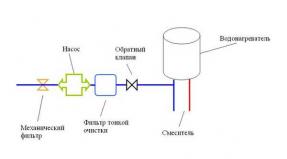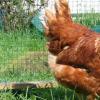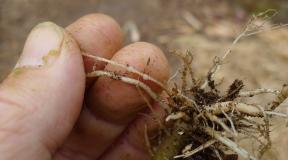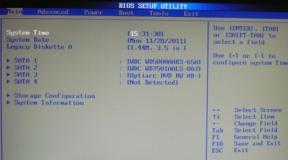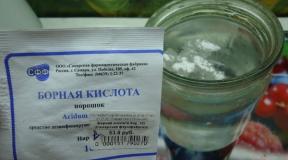Detercore Dolichogen in children: symptoms and effective treatment. Symptoms of intestinal dolichigm in a child, treating medication and folk remedies. Diagnostics and treatment of dolichosigma in the child's laxatives for children
Content
Perennial disputes continue between doctors - is this disease acquired or congenital anomaly. Intestinal Dolichogen - What is the diagnosis manifests itself in adults and children, what symptoms are observed at various stages of pathology development? To deal with this will help an overview of the causes of the illness, diagnostic methods, treatment and prevention of the disease.
What is a bowel valley
In the sigmoid division of the colon, the formation of elongation is sometimes observed, in which the wall thickness and the size of the lumen are not changed. Such an anomaly is called a dolichosigma. The elongation of the sigmoid intestine is accompanied by:
- the formation of loops, sharp infrections;
- increased mobility;
- circulatory disorders;
- innervation disorder;
- conducting failures, intestinal peristalsis.
The dolichosigma does not have its own code on the international classification of the disease ICD-10. It is believed to the group "Other congenital intestinal anomalies". General Code of Diseases - Q 43.8. The looped sigmoid loop can occupy in adults after 40 years, and in young children as a result of congenital pathology. A characteristic feature of the disease is a long constipation. When such a symptom appears, you need to consult a doctor to avoid complications:
- for kalova intoxication;
- intestinal obstruction;
- anemia;
- inflammatory processes.
Symptoms
The intestinal dolikhosigma in adults proceeds with the development of pain syndrome. As a consequence of lengthening and formation of loops occurs stagnant. In this case, patients are observed:
- increased gas formation;
- a dense, dryweed of a large diameter with a milder smell;
- bloating;
- pain in the aircraft region or left in iliac;
- spasms;
- driving in the intestines;
- disoccupatory sensations during exercise.
When the disease is in a launched form, long constipation causes intestinal damage, the formation of cracks, inflammatory processes. All this is accompanied by incessant pain. The body poisoning is occurring with key masses, in which the symptoms of intoxication are observed:
- loss of appetite;
- vomiting;
- weakness;
- lethargy;
- increased temperature;
- headache;
- drowsiness;
- smell from the mouth;
- cal with blood;
- development in adult hemorrhoids, gastritis, varicose, anemia.

Intestinal dolichmigm in a child
When such a trait appears, as a violation of the defecation, the child can be diagnosed with Dolichosigma. Publikov constipation develops with the introduction of a dust or transition to artificial nutrition aged from six months. The emergence of problems with the intestinal emptying after three years is not excluded. When diagnosing the dolichosigma, the child is observed:
- pallor skin;
- lag of physical development;
- body mass deficiency;
- when palpation - intestinal loops, filled with feces.
If you do not start the treatment of dolichosigma in children, complications are possible. There is a development of irritable intestinal syndrome, obstruction, anemia. Often, pathology is accompanied by the problems of other digestive systems. Dolichosigma in children are diagnosed together with the identification of diseases:
- colitis;
- dysbacteriosis;
- pancreatitis;
- biliary dyskinesia;
- gastroduodenitis;
- diverticular disease.
Causes of occurrence
A looped sigmoid gut may have a congenital deviation along the length. The anomalies of the structure provoke hereditary factors. There are such reasons for the occurrence of congenital dolikhosigma in a child:
- receiving a future mother medicinal preparations;
- infectious diseases during pregnancy;
- influence on the development of the fetus of chemical, physical environmental factors;
- problems in the work of the gastrointestinal tract.
The diagnosis of dolichosigma in adults is formed as a result:
- digestion disorders - the long fermentation process and rotting in the intestine;
- lifeline lifestyle;
- the abuse of meat and high carbohydrate food;
- frequent stressful situations;
- inflammatory processes in the intestines;
- chronic pathologies of the gastrointestinal tract;
- drug use;
- sitting work.
Dolichosigma classification
With the appearance of the beggars of the sigmoid intestine, three forms of illness differ. Each of them corresponds to a certain phase of the development of the disease. The classification implies the compensation stage at which:
- the emergence of constipation of up to three days;
- sharp abdominal pains;
- the emptying of the intestine that occurs with the help of a diet, receiving laxatives.
The two subsequent stages are characterized by a deterioration in the patient's condition:
- Stage of subcompensation. It is characterized by permanent pain, accompanied by meteorism, constipation, cope with which it is possible only with the help of frequent enema.
- The decompensation stage is the hardest form of the disease. Inxication of the body develops, rashes appear on the skin, there is an increase in the size of the colon, the symptoms of intestinal obstruction are possible. The normalization of the chair occurs only when using siphon enema.

Diagnostics
When contacting the hospital, the doctor produces a rectal examination of the patient, palpation of the abdomen to identify the stagnation of calm masses in the intestine. The study of blood for the presence of infections is performed. Analysis is assigned a common feces. Additionally, it is examined by worms on eggs, the presence of hidden blood. Diagnostics includes hardware methods:
- Ultrasound abdominal cavity - Helps to see the presence of dolichosigma, the expansion of the large intestine.
- X-ray study - reveals loops in a sigmoid department.
To accurate diagnosis, doctors are prescribed:
- Endoscopic study of the inner surface, intestinal mucosa - colonoscopy. At the same time, the method will be able to fence fabrics for biopsy in order to exclude oncology.
- Irrigoscopy - X-ray study using the introduction of a contrast agent. The method reveals the elongation of the site, the presence and number of loops.
Treatment of intestinal dolichmigm
The main task of therapy with the elongation of the sigmoid intestine is the normalization of the digestive system. Important moments - elimination of constipation, formation of defecation reflex. Treatment of dolichosigma includes a variety of methods. Doctors prescribe:
- compliance with the day mode;
- normalization of nutrition;
- medical physical education;
- abdominal massage;
- the use of physipesis;
- the use of drugs;
- application enema;
- hydrocolonotherapy - intestinal cleansing by washing with water using a special machine;
- in severe cases - operational intervention.
Conservative technique
With timely diagnostics, it is possible to cope with the disease without a surgical operation. Conservative treatment includes procedures and use of drugs. Doctors recommend:
- medical gymnastics To improve motility;
- swimming;
- introduction of gas into a hazing intestine;
- application of probiotics to improve digestion;
- detoxification - the removal of toxins by physical physician with vitamins;
- drugs for anesthesia, removal of spasms, laxatives;
- endoscopic childcare is the spinning of bends.
Medical preparations
To facilitate the symptoms of the disease, doctors prescribe medicines. Preparations produce diverse therapeutic effect. With Dolichosigma prescribe:
- Motilium - normalizes the peristaltics, prevents gas formation, is used in the form of tablets, suspension;
- Half a polyvitamin complex, contains biologically active substances, enzymes;
- But-shpa - removes spasms, reduces pain, no overdose is allowed;
- Prezero - increases the peristaltics, has side effects;
- DROTAVERIN - eliminates muscle spasm, applied in injections, tablets.

Diet
With Dolichosigma unacceptably overeating. Food needs to be taken in six receptions per day, pieces should be small, and the products are unsolved. Preferably cooking meals, steamed. Diet with a bowel valley in adults recommends:
- vegetables rich in fiber;
- whole grain porridge;
- oil - olive, linen;
- dairy products;
- soups and broths.
With the anomalies of the sigmoid intestine, use is prohibited:
- alcohol, especially red wine;
- white bread;
- pasta;
- canned fish and meat;
- carbonated drinks;
- fat meat;
- kvass;
- mayonnaise;
- sahara;
- acute ketchup;
- confectionery;
- fast Food Products;
- seasonings with horseradish, vinegar, mustard;
- manna cereals.
Physiotherapy
To activate the intestinal peristalsis, improve exchange processes In the tissues, physiotherapeutic procedures are prescribed to increase blood circulation. They are part conservative treatment Dolichosigmas. Such techniques are used:
- igloreflexotherapy - affects biologically active points;
- laser therapy - improves intestinal motorcycles, prevents the development of degenerative changes in the walls;
- power electrostimulation - affects the nerves and muscles electric shock, improves blood circulation, metabolic processes.
Surgical intervention
When the patient occurs in the capsement of the body, breaks are observed, non-painted loops, seals, a surgical operation is assigned. The testimony is the lack of effect from conservative treatment. During the operational intervention, which continues one and a half hours:
- used general anesthesia;
- the incision of the peritoneum is performed;
- dolikhosigma resection is produced - extra loops are removed;
- the abdominal wall is invented.
Treatment with folk remedies
- cabbage juice - half a compartment per day;
- dry bran - a teaspoon in the morning, in the evening;
- the decoction of berries is crash - 30 ml before bedtime;
- olive oil - a teaspoon before meals.

Forecast
If you do not give the treatment of dolichosigma, you can get serious problems. It is especially important to do this in childhood. The launched alert threatens stagnate masses, testicle breaks, inflammation of the mucous membrane, poisoning of the body. As the child develops, the intestinal motility can occur, the defecation functions. It is important to be under the supervision of a pediatrician, to carry out supportive therapy. Under the recommendations of doctors, you can:
- normalize stool;
- improve the quality of life.
Prevention
When performing all the appointments, you can cope with the appearance of the symptoms of the Dolichosigma. To avoid recurrence of the disease, it is necessary to carry out preventive measures. Would need:
- maintain water balance;
- organize proper nutrition, excluding the appearance of constipation;
- increase physical activity;
- observe the regime of labor and rest;
- under the course of treatment in the sanatorium;
- with the appearance of symptoms of the disease, urgently consult a doctor.
Video
Found in the text error?
Highlight it, press Ctrl + Enter and we will fix everything!
What is it - the intestinal dolichmigma? This is an abnormal elongation of the sigma, in which the wall thickness does not change, the intestinal diameter remains normal, and the length increases. Sigma at the same time becomes pathologically mobile and does not allow to form normally and move in cavalous masses, motility and emptying is disturbed. Because of its high length, it can be twisted, rig into the loop. The normal length of the sigma is 24-46 cm, with dichosigma it exceeds 46 cm and forms extra 2-3 loops.
Essence of pathology
The child's dolikhosigma can not manifest themselves, and some doctors refer to the peculiarities of the body. If such a sigma causes constipation and pain, gas formation and intoxication of the body, then this is already a disease.
Popps in young children are very frequent phenomenon, it is the problem of parents and pediatricians. But most often this phenomenon is associated with food, it is especially manifested by artificials. If constipation becomes constant, it indicates violations of the lower part of the intestine.
Dolichosigma on the ICD-10
Dolichosigma in children on the ICD-10 does not have its own separate code. She has one code with the group "Other congenital intestinal anomalies", with such pathologies, such as blind intestinal syndrome, intestinal diverticulus, dolichocolone, microcolone, megaloapependix, transposition of appendix, megaloduodenum - q 43.8.
Mechanism of appearance

So what is it - the intestinal dolichmigma? It happens acquired and congenital. For children, the second option is characteristic, pathology arises even during embryogenesis. At the same time, the sigma has 2-3 extra loops.
The acquired option is found in adults after 45 years, mostly those who lead a low-wear lifestyle and loves oily food. Why an dolichosigma occurs in a child, it is not clarified so far. Some talk about bad heredity. The other appearance of dolichosigma in a child during the newborn period is associated with infectious diseases during pregnancy or reception of some drugs by the future mother. There is also no consensus on whether the pathology is a vice formation of the final intestinal department.
Some researchers consider a pathological sigma by an option of the norm, because it is often common and detected in 25% of children, no complaints of not presenting. But in contrast to this opinion, there is another - the disturbed length of the sigma is accompanied by an organic or functional deflection in the structure of the final segma and rectum. It is expressed in chronic inflammation of the mucous membrane, intestinal stainy, increasing muscle fibers, sealing mesentery tissue, damage to intramural nerve ganglia and violation of cellular metabolism. In other words, the Dolichosigma leads to degenerative integration of the intestine and violates her work.
The main causes of appearance
Reasons are unknown, but the predisposing factors are established:
- complications of pregnancy;
- infections during gestation;
- hypovitaminosis and deficit of proteins in the nutrition of the mother;
- bad ecology during pregnancy mother - raising radiation background, gaspace, low quality drinking water;
- bad heredity;
- reception of drugs during pregnancy.
Symptomatic manifestations

In 70% of cases, symptoms manifests itself up to a year. In 30% of cases of stool disorders, there are 3-6 years. The first symptoms of Dolichosigma in children are usually manifested in 6 months. Publishers and stagnants are immediately arising with the introduction of the first dust, when moving to artificial feeding.
Poinons become the main symptom. The rest of the clinic is developing gradually. She manifests itself in capriciousness, lethargy, crying, refusal to breast or from food, bad sleep and shouts during the day. Symptoms weaken only when the child goes into the toilet. Reducing local immunity is manifested by small guns on the skin.
The chair does not happen for 3-4 days, and the intestinal cleansing becomes a problem. At first, the feces occurs once every 3 days, then once a week, and later and a month.
Stagnation feces poisoning the body, it is compacted, increases and acquires a malicious smell of rotting. Solid calaiming masses at their slow promotion injure the mucous membrane, blood begin to mix blood. Sigma is stretched, and the walls are thinned. This may end the perforation. If enemas are constantly used, emptying reflex decreases.
For older children, symptoms are manifested as follows:
- pain in the stomach around the navel or on the left;
- constipation;
- nausea;
- nail fragility;
- snakes in the corners of the mouth;
- weight loss and loss of appetite (hypovitaminosis);
- face pallor;
- lip bias;
- flatulence;
- rumbling;
- nasty smell from mouth;
- accession of gastritis, chronic pancreatitis, colitis, hemorrhoids.
The child seems tired, he often refuses meals, he has a rapid heartbeat, he refuses the games. Due to constipation and pain, the child is afraid to ask for a toilet. Especially symptoms are exacerbated after a large portion of food or exercise.
The course of the disease
Dolichosigma takes place in three stages or forms with different severity of manifestations:
- The stage of compensation is the initial and easiest. Popps are not always bothering, there are 3-4 days, leave after defecation, the pains are nele. The general condition does not change, the child is active enough. Stage is easily treated with diet and laxatives.
- The stage of subcompensation - the chair also absent more than 3 days, but now constantly. The belly will break, hurts. The baby eats badly, does not finish weight and irritable. Lastabilities become not enough, you have to use enemas. The first signs of body intoxication appear.
- Stage of decompensation - all the symptoms are bright, launched. Long constipation, intoxication is expressed: headaches, poor appetite, rashes on the skin, nausea and vomiting, anemia and lethargy. The belly will be taken constantly and hurts all the time. Empty times a week or a month. Possible signs of the belly have to be used only siphon. Performance treatment is only surgical.
Diagnostic events
Diagnosis of dolichosigma in children is raised after a comprehensive blood survey, feces, instrumental research methods. First, the visual inspection reveals the weight deficit and the pallor of the child, the peeling of the skin on the fingers due to avitaminosis.
Palparato felt that the belly is filled with loops. The finger study shows that the rectum is empty.
Irrigography will help identify the degree and number of curls of the loops, the magnitude of the sigma. Additional loops can be in the form of "eight", "snail", "node".
For diagnosis, the older children use CT. This technique allows you to determine the volume formation. Little children CT are impossible due to their mobility.
Also prescribe an ultrasound, x-ray, irrigoscopy, a colonoscopy, a common and biochemical blood test, the analysis of the feces on the eggs of worms and the presence of hidden bleeding. On the ultrasound, the intestine is clogged with a dense fender. What do feeds about the examination of the Dolichosigma in the child? Many parents are experiencing that this procedure causes discomfort and pain. Many moms categorically do not go to the survey precisely because the child is simply unable to endure the procedures and is afraid. Others believe that the barium used for irrigoscopy will cause infertility in the girl in the future. Some consider the reception of Baria disgusting, his and adult will not drink.
All these fears are devoid of grounds. Many carry the procedure easily. Moreover, when colonoscopy, for example, children are introduced short anesthesia.
Complications of Dolichosigma
In the absence of attention and treatment, it is noted:
- physical development delay;
- anemia;
- dumpless skin diseases;
- obstruction of the intestine due to honeystones;
- caltal intoxication.
Principles of therapy
Children's children's gastroenterologist are engaged in the treatment of the intestinal dolichigm.
The purpose of therapy:
- Normalization of feces.
- Setting the chair of the chair.
- Renewing the intestines to stimulate the gastrointestinal tract.
- Removing acute inflammation.
For crushing of honeystones, abdominal massage and therapeutic gymnastics are used. This leads to a tide of blood to the intestines and strengthens the abdominal muscles. To improve the functioning of the intestine, prescribe physiotes. Treatment begins with diet and malfunction of the power mode.
Special diet
It is necessary to ensure the water and drinking mode. At least 10 glasses of water per day should be drinking. Food should be fractional - 5-6 times a day, small portions, strict in time. Well helps water with lemon, which dilutes the chair. Meat is prohibited, a glass of 1% kefir is required.
Child menu at Dolichosigma: more products with fiber (berries, greens, fruits). It is necessary for their heat treatment - boiling or cooking for a pair. All that is covered with an appetizing crust, as well as fried, smoked, sharp is excluded. Also contraindicated dishes that slow down the movement of kala in the intestine, - rice, manka, millet, pasta, white bread, dob, cookies and cakes, coffee, cocoa, strong tea. Animal fats enhance fermentation and are poorly absorbed. With regard to chocolate: it can be given rarely, it is impossible an hour before meals and after it.
You can give the child to give fish, cottage cheese, dairy products, buckwheat porridge, salads, vegetarian soups. Branches are recommended, vegetables and fruits are shown beets, prunes, carrots, figs, pumpkin, baked apples, apricots, plums, dried apricots. From sweets, you can compote, limited honey, marmalade (contains pectins).
Bananas, grapes and pears are excluded. Diet with due to the limited choice of products is complemented by polyvitamins with a content C, A, E, group B, D. They will support immunity.
Medicia treatment

- Embled enemas, laxatives (feces increase), prokinetics, means to reduce the feces.
- "Motilium". He accelerates the evacuation of the food lump. He is prescribed for 2 weeks.
- In the absence of the effect of the diet, laxatives are used, and begin with minimal doses.
- Pain in the stomach and gas formation is removed by Dibazole and Poszero in injections. Prezero increases the tone of the intestinal walls. The effect increases at times, if it is combined with electrostimulation of a thick bowel.
- Safety spasmolitis are ineffective, because pain is not caused by spasm, but an intestine atony.
- An important step is the rehabilitation of the intestine microflora, for which they are prescribed pre- and probiotics: "Bifidbacterin", "Lactobacterin", "Narina", "Linex", etc.
- In the medical treatment of the intestinal dolichigm in children to improve the well-being, the doctor appoints "Duhalak", "Psychology", "Mukofalc" (these drugs from the seed shell of the plantain), "Duspatalyn", "Festal". Their action is multilateral: increasing the tone of the intestinal wall, sneaking feces, strengthening the intestinal motility.
The effect of treatment can be strengthened by herbic booxes and infusions, but only after consulting a doctor. Preparations are used to reduce meteorism, to reduce the smell of feces.
Methods of physiotherapy
Physiothereders at Dolichosigma in children are valuable in that they are able to normalize the work of the intestine. Effective are considered:
- intestinal electrostimulation for 2 weeks with long constipation;
- laser therapy;
- igloreflexotherapy;
- electrophoresis with toning substances.
Attitude towards hydrocolonotherapy is negative due to many complications.
Using enema
The enema is made with clean water or brine, decoction of daisies. Calling to emptying arises as a reflex. The volume of water depends on the age of the child. The temperature of the solution should not differ from the body temperature of the kid.
The baby is put on the right side, the tip of the enema must be lubricated with vaseline oil. After the injection of the liquid, the butterms should be squeezed and displacing the child in hand for 10 minutes, after which the baby must be planted on a pot.
Emmers, even with their effectiveness, you need to use as much as possible, it is better to form a reflex to defecation so that the toilet visit is calm.
What is useful for massage

Massage at Dolichosigma in a child is a mandatory component of treatment. It is not done only in blood in feces. Breasts Massage back and belly are necessary daily to strengthen muscles.
Procedures are conducted when the baby is laid out on the stomach. Two fingers carefully make spiral movements along the spine from the waist and down, to the tailbone. The stomach is massaged with circular motions clockwise. Massage must be pleasant to the child, otherwise there will be no screaming and crying other results.
The beginning and end of the procedure - in the form of strokes and rubbing. Metal movements must be slow, pressing.
In the reverse order produce tapping the phalanges of the fingers. The whole procedure lasts at least 20 minutes. It is better to carry out massage in the morning, to feeding.
Therapeutic physical culture is shown to higher children. Better, if it is group classes, where kids are looking at each other. Then they repeat the movements of the neighbors and are learn faster. Stimulate the purpose of the intestine is also jumping on the spot with a skipping, running, rugging a hoop.
Surgical intervention

If various methods of conservative treatment do not reveal positive results and the disease continues to progress, there is addictive to the toes, intoxication is expressed and continues to grow, resort to radical cure methods.
Operation at Dolichosigma in a child attending a doctor can only recommend in extreme cases.
Indications for surgical intervention:
- lack of positive dynamics from conservative treatment;
- pronounced intoxication;
- intestinal obstruction;
- paving part of the pipe to another - "wrapped stocking";
- twisting, spikes and cigma geeks;
- the presence of honeystones.
The operation is performed only at 3 stages of the disease. Contraindications for surgery: Heavy Pathology of the CNS and Cardiovascular System.
Surgical intervention is carried out under general anesthesia. The cutting off the unnecessary loops of the sigmoid intestine and stitching the ends - the upper and lower one.
Operation on resection Sigma is called proctosigmoidectomy. With suspected intestinal obstruction, the entire intestines revise, because twisting moving loops squeezes and disrupts the nutrition of the intestinal walls, causing necrosis of tissues. Then, part of the extra sigma is removed, and other bowel deposits are removed.
The duration of the operation is 1.5 hours. Removal of unnecessary loops allows cavalous masses normally pass through the intestines. After the suffering disease for the best and rapid recovery Very useful sanatorium resort treatment.
What are the forecasts

Diet, the reception of discharged drugs will help the child at the first two stages definitely. At the same time, the chair will be regular.
In the 3 stages, the solution is individual, it is determined by a number of factors. Complications occur when Ignoring the process in any case. It is ultimately formed by the carte masses that can no longer exit. At the same time, there is rotting nutrition and poisoning of the body. The forecast in such cases is unfavorable.
Preventive actions
After eating, the abdominal massage is desirable, especially kids. Power must be fractional, without overeating. According to the reviews of many parents, problems with a chair in the summer in the child pass or significantly decrease. Good reviews about "Microlax" and "Dufahalak".
The reasons for the occurrence of the intestinal dolichigm are still not identified. In most cases, this is a congenital feature, and it is often found. By the origin of the dolichosigma can be two types:
- Intrauterine. If during the first trimester of pregnancy occurred the influence of negative factors: chemical, environmental, infectious.
- Acquired. It is much less common and is a consequence of coarse disorders of digestion, such as long-term fermentation and rotting, which are a consequence of existing unhealthy habits in food. Appears in people who have reached 40-50 years leading a sedentary lifestyle.
The main symptoms accompanying this state are:
- stool delay and;
- painful feelings in the stomach;
- meteorism and bloating.
There are three stages of development of intestinal dolikhosigm:
- Compensated - problems with the latency of the chair have an episodic character and will not last for more than 3 days. The well-being remains normal, but rare abdominal pain can be disturbed. The regularity of the chair is restored by compliance with a special diet or use of laxatives. During Palpation, you can find the intestine filled with honey masses. There is a violation of the motility of the sigmoid gut.
- Subcompensated stage - this stage is characterized by more frequent constipation, which deliver discomfort to the child. At the same time, the laxatives and observance of the diet do not bring the desired effect. The child can feel abdominal pain, bloated and meteorism. Defecation cannot occur independently, and the intestines empties only after the cleansing enema.
- Decompensation stage - constipation acquire a permanent character, the child is worried about the abdominal pain. General well-being can worsen due to the lack of appetite, headaches and nausea, anemia develops. There is intoxication of the body. The intestine increases in size due to the accumulation of carts and gases in it. Emptying the intestines occurs only with the help of a siphon enema.
Treatment of children with a bowel valley can be carried out in two ways, conservative and operational. In most cases, surgical treatment is carried out, which is to restore the normal regular chair. This goal is achieved by applying such an event as medical diet.
But it is possible to achieve a decrease in the symptoms of manifestation subject to the correct nutritional and motor activity of the child. Children with a detected intestinal valley are under the supervision of a gastroenterologist. The radiological picture of the abdominal cavity will also reveal this pathology. It is more accurate to diagnose and determine the presence of pathology will help irrigography - this is an x-ray, during which a special mixture is introduced and it becomes possible to clearly identify the presence of unnecessary loops in the intestine.
The diet should be replenished with products containing a large amount of pectin. It will stimulate the intestinal work. It can be baked apples and pears, zucchini dishes, pumpkins and fresh vegetables in the form in which it is easier and more convenient to use the child. The daily use of fruit will fill the organism by the fiber, which is very favorably affects the intestines, helping to warn constipation. You can add branches to food.
Very recommended consumption of fresh milking products. As meat dishes, you must give preference to fish and poultry meat. It is necessary to observe the water regime and use pure non-carbonated water in the desired volume and compotes from dried fruits. For the child, it is recommended to cook porridge from buckwheat, millet and oatmeal.
Conservative treatment of dolichosigma includes a massage of the anterior abdominal wall and therapeutic gymnastics, which improve the intestinal peristalsis. Drugs used in the elongation of the sigmoid intestine in the child should be limited to light laxatives containing extremely vegetable components in their composition.

Terms "Dolichosigma
"(The elongation of the sigmoid intestine)," Dolichokolon "clinicians and radiologists use quite often, but not the clear boundaries of the lesion at the same time are not established. In the last century, the doctors noted that the elongated sigmoid gut is one of the frequent causes of chronic constipation in children.
In the special literature there are a lot of work describing the position of the sigmoid intestine in the abdominal cavity and its size. All authors recognize the significant variability of these parameters. M. S. Khechinashvili, who studied the sigmoid gut in newborns, allocated the following options for its position: S-shaped (53%), single-counter (27.8%), biblly (57%), multi-fledged (9.9%).
Our studies have confirmed the opinion of the significant variability of the position of the sigmoid intestine, and this is more pronounced in children aged 0 to 7 years. Dolichosigma we stated in 15% of healthy children, considering the elongated multi-foste or double-minded sigmoid gut, when the loops are located in the abdominal cavity, reaching a spleen or liver bend of the colon. At the same time, the intestine is overly moving, fluidally moves in the abdominal cavity, the addition hinges are preserved and after emptying the intestine.
If earlier the dolichosigma pathogenetic tied with the advent of chronic constipation, then the question is currently being discussed: it is considered or not its congenital definition of development, that is, it is about etiological dependence. A number of authors rank a dolchosigma to the vices of the colon development, others see it not an anomaly, but a development option.
Observing over the past years more than 1,000 children suffering from chronic constipation and recurrent abdominal pains, we revealed a dolikhosigma with a thorough dynamic observation in 25%. N. L. Kushch, Z. A. Trofimova and A. V. Makarov, examining children about chronic constipation, discovered a dolichosigma in 30-40%.
Thus, on the one hand, the elongation of the sigmoid gut often happens in completely healthy children, which gives reason to consider it a variant of the norm, on the other hand, the dolichosigma is often accompanied by chronic constipation and recurrent abdominal pain.
What involuntarily pursues the idea of \u200b\u200bdevelopment anomaly.
V. V. Klimanov, studying the histostructure of the elongated sigmoid guts, discovered changes in all layers of intestinal walls, which were maintained mainly to myofibrosis with an edema of connecting tissue against the background of muscle hypertrophy, lymphogistocitary infiltration, dystrophy of the mucous membrane epithelium, expansion of lymphatic slots.
Electromiographic studies were conducted to study the motility of the Sigmid intestine at Dolichosigma. Their results are consistent with the results of pathogistological studies and indicate significant violations of the motor function of the sigmoid intestine with congenital elongation, expressed mainly in the distal part.
Provocated activity (response to the introduction of prozero and mechanical irritation of the intestine wall) indicates the initial damage to the synaptic apparatus. Weakening Motorika distal department It is accompanied at the first time the compensatory strengthening of the activities of the overlying departments, which sometimes determines the secondary dilatation of the gossip.
Symptoms and Diagnostics of Dolichosigma
. Parents complain of chronic constipation in a child or periodically emerging abdominal pain. Chronic constipation caused by a violation of the motility of the sigmoid intestine, in most children (60%) arises during the first year of life and usually coincides with the transfer of a child to artificial feeding or the introduction of feeding;
in 40% of children, constipation appears at 3-6 years. The abdominal pain associated with the stained of intestinal contents, flatulence, as well as the inflection of excessive loops and partially by their breakdown, the presence of adhesions and mesenter scars, appear later - usually not earlier than 5-7 years. Sometimes pain is accompanied by vomiting.
Dynamic observation of children aged from 3 to 14 years, in which the degree of detects detected, gives the grounds to distinguish three clinical stages depending on the severity of symptoms and the clinical picture: compensated, subcompensated and decompensated.
Compressed stage Dolichosigma
It is characterized by episodic disorders of the intestinal function in practically healthy children who have in X-ray-sensitive research gastrointestinal tract An elongated sigmoid intestine was found. Part of the children complain about episodic attacks of stomach pain, mainly in the lower departments.
In some cases, pain is accompanied by vomiting and bloating, which usually disappear after the cleansing enema. Some children are urgently operated with suspicion acute appendicitisBut after the operation, the pain does not stop. The physical development of children with a dolichosigma in a compensated stage corresponds to age. When palpation, the accumulation of carts is absent along the course of the colon, the stomach is painless, the correct configuration.
In the subcompensated stage
Complaints on periodic constipation duration up to 2 to 3 days with subsequent independent emptying of the intestine. Many parents noticed a violation of the defecation regime over the age of 2 years. Especially often constipation arise in winter and early spring, and in the summer and autumn months there is a pretty resistant remission.

This is undoubtedly connected with food, that is, with the specific weight of fruits and vegetables in the diet. In contrast to children with a dolchosigma in a compensated stage in children of this group, abdominal pains and meteorism appear more often. The accumulation of feces along the colon - the phenomenon is also frequent, so parents often put the balls with the enema.
Mechanism of appearance
Doctors believe that an anomaly of the length of the sigmoid intestinal system is quite often common in children. It is discovered in 25% of newborns during the examination. In most cases, the child does not feel pathology, so it is recognized as an individual physiological deviation.
The pathological validity of the intestinal changes are considered in the occurrence of violations in the formation of powerful masses and the motor function to deliver them to the anus. Up to 30% of cases are recognized as congenital anomalies in the formation of an intestinal tube of the fetus. The rest may occur in the child in the acquired order due to impaired digestion, putrid fermentation in a sigmoid intestine, its stretching with gases and carte masses, the formation of new loops.
Not all pediatricians agree with such a interpretation. Some believe that in childhood there can be no reason for the acquired disease. Pathology is available from birth, but not immediately manifested. Provoked by improper nutrition of a nursing mother and baby, the lack of sufficient care for the child.
There is a congenital and acquired form of the disease. Doctors did not come to the unequivocal conclusion about the time of the appearance of the disease. The first wave of diagnoses takes place at birth, the second after 45 years. Perhaps people live with an abnormal structure of the intestines all their lives, without suspecting it. Only with the beginning of age-related changes in the digestive system begin again the symptoms of congenital dolichosigma begin.
So what is it - the intestinal dolichmigma? It happens acquired and congenital. For children, the second option is characteristic, pathology arises even during embryogenesis. At the same time, the sigma has 2-3 extra loops.
The acquired option is found in adults after 45 years, mostly those who lead a low-wear lifestyle and loves oily food. Why an dolichosigma occurs in a child, it is not clarified so far. Some talk about bad heredity. Other appearance in the neonatal period is associated with infectious diseases during pregnancy or reception of some drugs by the future mother. There is also no consensus on whether the pathology is a vice formation of the final intestinal department.
Some researchers consider a pathological sigma by an option of the norm, because it is often common and detected in 25% of children, no complaints of not presenting. But in contrast to this opinion, there is another - the disturbed length of the sigma is accompanied by an organic or functional deflection in the structure of the final segma and rectum.
Reasons are unknown, but the predisposing factors are established:
- complications of pregnancy;
- infections during gestation;
- hypovitaminosis and deficit of proteins in the nutrition of the mother;
- bad ecology during pregnancy mother - raising radiation background, gaspace, low quality drinking water;
- bad heredity;
- reception of drugs during pregnancy.
Diseases that accompany Dolichosigma
Dolichosigma takes place in three stages or forms with different severity of manifestations:
- The stage of compensation is the initial and easiest. Popps are not always bothering, there are 3-4 days, leave after defecation, the pains are nele. The general condition does not change, the child is active enough. Stage is easily treated with diet and laxatives.
- The stage of subcompensation - the chair also absent more than 3 days, but now constantly. The belly will break, hurts. The baby eats badly, does not finish weight and irritable. Lastabilities become not enough, you have to use enemas. The first signs of body intoxication appear.
- Stage of decompensation - all the symptoms are bright, launched. Long constipation, intoxication is expressed: headaches, poor appetite, rashes on the skin, nausea and vomiting, anemia and lethargy. The belly will be taken constantly and hurts all the time. Empty times a week or a month. Possible signs of the belly have to be used only siphon. Performance treatment is only surgical.
Depending on the reasons for provoking the problem, the dolichosigma may be congenital and acquired.
In the development process, the disease passes through several stages, for each of which are characterized by their special symptomatic manifestations.
Compensated. In this case, constipation arise with tangible breaks and lasts for a maximum of 5 days. There is also a tangible abdominal pain. Otherwise, the patient feels fine. In order to empty the intestine, the patient should use ebizes and laxatives.
Subcompensated. The intestinal dolichigm at this stage leads to tangible pains, constant constipation and bloating. Laxative preparations are no longer able to provide the desired level of passability.
Decompensated. This form is the final stage. There may be a violation of the movement of carts and food by intestines. Pain in the stomach does not pass, and constipation lasts all week. Immediately the gut itself increases in size and is inflated due to the accumulation of gases and carts in it. Against the background of such a state, intoxication may develop ( toxic substances poison the body). All this is accompanied by purulent rashes on the skin, nausea, vomiting and lack of appetite.
Immunodeficiency. This pathology becomes the cause of inflammatory changes in the intestinal walls and causes an increase in the amount of diseases during the year, affects the attachment of various infections and the emergence of skin manifestations due to intestinal disorders.
Gastroduodenitis, esophagitis and gastritis. The intestinal dolikhosigma affects the development of these diseases by disrupting the passage of the carts, which, in turn, leads to the imbalance in the work of various organs of the digestive tract, chronic dysbacteriosis and gases accumulation.

Chronic stress. Such a condition of a person leads heartburn, constant pain and bloating. Directly the stress itself, which is a consequence of a decrease in tone (due to pain and discomfort), may cause gastritis and other complications.
The development of dolichosigma in the child passes 3 stages. Some pediatricians call them forms. They differ in severity of symptoms, reactions to therapeutic measures.
- I (Compensation Stage) is the easiest, constipation in a child are inconsistently, held for 2-3 days, the pains are nesting, disappear after defecation. The general condition is good, the activity and development of the baby do not suffer. It is good to treat diet and light laxatives.
- II (subcompensation stage) - constipation becomes familiar, the chair is missing for more than three days. The bloating is appearing, painful syndrome. The child is irritable, eats badly, behind weight. To purify the intestine, it is necessary to use enemas, diets and laxatives is not enough.
- III (decompensation stage) - the picture of the disease is pronounced, the symptoms are launched. The child suffers from long constipation, there are signs of intoxication (headaches, lethargy, nausea, vomiting), anemia and avitaminosis. Pain in stomach and bloating keeps constantly. There are seizures of partial obstruction of the intestine. Clear the intestines of the child help only siphon enemas. This state is perfectly treated only by a surgical method.
Clinical manifestations of the disease are due to functional changes in the colon and chronic cartoons intoxication. The leading manifestation of Dolichosigma is stubborn constipation that can last up to 10 days in a row. Due to the long lack of an act of defecation, an unexpected detergent can happen, which he cannot control. Cal leaves slowly, painfully, has an unpleasant smell, dense consistency.
First symptoms
The timing of the development of symptoms of pathology is different. They depend on the degree of extension of the intestine, changes to its motor skills and tone, compensatory capabilities of the body. More often, the dolichosigma develops aged 6-12 months. This is due to the introduction of the attachment or translation of the infant for artificial (mixed) feeding, which entails an increase in the number and sealing of the consistency of the carts. The first symptoms of Dolichosigma:
- constipation have an episodic character, the chair is missing 2-3 days;
- dilatation (stretching) of the intestine, aggravation of morphological changes;
- reducing the reflex for defecation;
- encuprex (incontinence of feces).
In later stages
With the further development of the pathological process, the frequency and duration of constipation increase. Cal in children becomes a large diameter, sometimes resembles a fir bump, often has a malware smell. Damage to the rectum during the passage of dense potassium masses causes the appearance of blood scars in the stool. Characteristic clinical signs At the late stage of the Dolichosigma in a child:
- recurrent pains in the ocoloppy or left iliac region;
- flatulence;
- spasm of guts;
- the formation of hall stones;
- inflammatory processes in the intestinal wall;
- scooted changes in the mesentery of the sigma.
Signs of the toddler intestines can manifest itself at different ages, but more often develop in the second half of the first year of the child's life. This is explained by the fact that during this period, parents begin to actively introduce lures.
Symptoms of the existing dolichosigma begin to actively manifest itself during the administration of dust (6-10 months)

The digestive system cannot quickly rebuilt on the new mode, so it is often compacted and the process of its removal is hampered.
The most obvious symptoms of the Dolichosigma:
- Constipation that continue from 2 to 10 days. The duration of the state speaks of a severe degree of the disease.
- Calate delay provokes a sharp emptying of the intestine, which is called Enchnoprez.
- After emptying, dense carts are observed, which are reminded by Kosii Kal. At the same time, they exude an extremely unpleasant smell.
- Periodically, or constantly the child feels unlock or pronounced pain in the left ileal region.
- Skin covers become dry and acquire a pale shade. This is due to the impaired admission to the body of vitamins and nutrients. At the thin child, the belly acquires large sizes, sigma becomes compacted and painful.
- The kid feels almost constant bloating and painting the abdomen.
Table 2. Diagnostic methods of Dolichosigma
| Procedure | Feature |
|---|---|
| Palpation | The doctor feels belly and the rectum to identify the possible presence of tumors and other neoplasms. |
| Ultrasound | |
| Radiography | Allows you to see extra loops in the sigmoid intestine. |
| Irrigography | Allows you to see extra loops in a sigmoid intestine using a barium mixture. |
| Colonoscopy | With the help of the chamber on the hose, the state of the intestinal mucosa is estimated, the presence of unnecessary loops and pathological neoplasms. You can take a biopsy of tissues. |
| RectoManososcopy. | With the help of an endoscope, the state of the intestinal mucosa is estimated. |
Additionally, all patients must pass a number of laboratory tests. These include general and biochemical blood test. Be sure to check the presence of blood clots in the cartoons. With the help of the comprogram, a possible disruption of microflora and the presence of untapped products in feces are revealed. Sometimes it is assigned a blood test or feces on helminthiasis.
If you immediately begin therapy, in 90% of cases it is possible to fully suppress unpleasant symptoms, translating it into the step of remission. In a matter, due to permanent constipation, intoxication of the body can develop, hemorrhoids will appear, in some cases there is intestinal obstruction, which can be cured only by urgent surgery.
Causes of Dolichosigma
Congenital
- hereditary predisposition;
- reception of pregnant synthetic drugs;
- disease during pregnancy infectious pathologies;
- negative impact on the fruit of the environment, radiation;
Acquired
- chronic diseases digestive system;
- work sitting;
- increased nervousness, constant depression;
- long-term treatment with potent drugs;
- incorrect meals when the focus is made on food rich in carbohydrates. Consumption of a large number of meat products;
- the presence of bad habits.
A violation that usually begins in childhood, gradually leads to a change in other organs. Begin failure in the digestive system, other problems. Upon delay in the promotion of carts, the accumulation of intestinal gases begins dysbacteriosis, other deviations in the operation of digestion. The usual satellites of the disease are gastritis, gastroduodenitis, other digestive problems.
Permanent pains, frequent bloating, high gas formation holds a person in voltage, lowers the total tone of the body. All this quickly leads to the development of stress. This condition is a predisposing factor in the development of gastritis.
Immunodeficiency occurs due to the impossibility of normal intestinal operation. Gradually, there is an accession to any infections, the body does not cope with them. Symptoms of intestinal problems are manifested by specific rashes on the skin.
Children additionally revealed pancreatitis, colitis, dyskinesia of biliary tract, disorders of other digestive systems. In adults to the disease, varicose disease, hemorrhoids.
The chair does not happen for 3-4 days, and the intestinal cleansing becomes a problem. At first, the feces occurs once every 3 days, then once a week, and later and a month.
Stagnation feces poisoning the body, it is compacted, increases and acquires a malicious smell of rotting. Solid calaiming masses at their slow promotion injure the mucous membrane, blood begin to mix blood. Sigma is stretched, and the walls are thinned. This may end the perforation. If enemas are constantly used, emptying reflex decreases.
For older children, symptoms are manifested as follows:
- pain in the stomach around the navel or on the left;
- constipation;
- nausea;
- nail fragility;
- snakes in the corners of the mouth;
- weight loss and loss of appetite (hypovitaminosis);
- face pallor;
- lip bias;
- flatulence;
- rumbling;
- unpleasant smell of mouth;
- accession of gastritis, chronic pancreatitis, colitis, hemorrhoids.
The child seems tired, he often refuses meals, he has a rapid heartbeat, he refuses the games. Due to constipation and pain, the child is afraid to ask for a toilet. Especially symptoms are exacerbated after a large portion of food or exercise.
The reasons for the development of dolichosigma in adults and children today are not yet accurate. But several major theories have been put forward. It is worth noting the fact that this pathology is two species - congenital and acquired. Most often in children diagnose precisely the congenital form of pathology. Attentive parents can notice signs of pathology in the first month of the child's life.
Congenital dolichosigma can develop under the influence of the following factors:
- genetic predisposition;
- unfavorable environmentally conditions in which there was a mother while tooling the fetus;
- reception of pregnant women of some groups of synthetic medicines;
- in children, Dolichosigma can also develop due to the fact that during pregnancy, the mother got a few infectious nature.
The acquired form of the intestinal dolichigm rarely when developing in children. Usually this pathology is striking people after 45 years, which leads an inactive lifestyle, consume too much carbohydrate and meat food. The acquired form begins to progress due to digestive impairment, which occurred due to prolonged fermentation and rotting of food in the intestine.
– frequent problem, usually they are associated with the features of the child's diet and pass after some time. But if the difficulty of the act of defecation occurs regularly, it is more serious about this problem. This manifestation is a symptom of a number of diseases. Dolichosigma is one of these pathologies.
Dolichosigma is the structural anomaly of the sigmoid division of the large intestine. With this pathology, the sigmoid intestine is extended, but its lumen does not change in diameter, and the walls do not become thicker.
Epidemiology
Epidemiological data on Dolichosige are as follows:
- in 80% of cases of dolichosigma in children are due to the cessation of neural migration in the intestine and innervation violation;
- asymptomatic and non-disturbing patients disease is diagnosed in 15% of people;
- the intestinal damage along the entire length occurs in 1% of victims;
- among the newborn, only 1 out of 5,000 children have this pathology;
- the disease is 4 times more common in boys;
- family history of the disease is observed in 7% of cases;
- in 3 - 5% of victims, pathology is associated with defects, for example,.
Causes of Development Dolichosigma
Until now, the exact causes of such anomaly have been revealed. Sometimes congenital pathology is the result of the effects of radiation, toxins, various chemical and physical factors during intrauterine development. Dolichosigma can also develop if a woman has suffered an infectious disease during pregnancy. The proper development of the fetus may disrupt the use of a pregnant woman of individual drugs.
The acquired dolichosigma in children rarely appears. The reasons will be the following:

- long constipation, fermentation and rotting processes in the intestine after a protracted dysbacteriosis or long-term infection, frequent food poisoning;
- violation of the intestinal motor activity due to a sedentary lifestyle;
- excessive use of meat products, carbohydrate diet;
- resistant nervous overvoltage and stress.
Mechanism for the development of the disease and its manifestations (pathogenesis)
An innode or acquired increase in the length of the sigmoid gut underlies pathogenesis. If there are accompanying pathologies, fibrosis of the intestine tissue does not rack, as a result, the junction tissue replaces the normal bowel tissue. Hyperemia appears and personnel. Muscle fibers grow, as a result of which the intestinal walls are abundantly soaked with tissue fluid.
All this disrupts the contraction of the intestines and weakens its tone. Reducing the reduction processes makes it difficult to pass the feces in the intestine, as a result, constipation develops. Due to the constant finding of feces in the intestine, cell innervation is disturbed, stagnation, pain and intoxication develop.

Symptoms arise as the intestines filling faeces and the development of intoxication of the body. The intensity of the severity of the disease is directly proportional to the degree of morphological and functional disorders in the intestine.
In comparison with other tractures of the gastrointestinal tract, Dolichosigma is represented by bright characteristic symptoms. Here are some of them:
- sick children arises multi-day constipation. With its progression, the desire for the act of defecation occurs, the mass of the chair becomes denser. Dense callers often cause damage to the mucosa of the rectum, so blood appears during the act of defecation. In severe cases, the emptying of the intestine without enema becomes impossible;
- pain with dolichosigma is localized in the navel area and is spasmodic. Painful sensations arise from the left side and immediately after the act of defecation disappear;
- this pathology also causes strong meteorism, resistant bloating and rumbling;
- standing constipation leads to intoxication of the body, so the child has weakness and nausea, the appetite disappears, and the skin becomes gray, a rash appears on it. It is possible to occur incontinence of urine.
Sometimes an anomaly proceeds completely asymptomatic, it is found randomly either during the usual prophylactic examination, or in a diagnostic study associated with another TAP problem. But, as a rule, the symptoms mentioned above arise and bring serious discomfort to the sick child.

A child with a dolichosigma becomes sluggish, capricious, he cries and refuses meals all the time. The main feature is constipation with a gradually increasing frequency. This is usually due to the transition to mixed feeding or, which entails a change in the feces consistency and an increase in its quantity.
Most of the affected children detect functional disorders of other parts of the gastrointestinal tract: diverticular disease, colitis, dysbacteriosis, pancreatitis, dyskinesia of greyweight paths, chronic gastroduodenitis, etc.
Stages
There are three stages of abnormal elongation of the sigmoid intestine.
| Name stage | Characteristic |
| Compensation | Periodically appear constipation duration of about 3 days. Perhaps the presence of abdominal pain. Compliance with a special diet and reception of lung laxatives will allow to restore evacuation functions. |
| Subcompensation | Resistant constipation arise in combination with abdominal pain and strong meteorism. Lactful means cannot be restored by evacuation functions. The intestinal emptying is achieved by applying the cleansing enema. |
| Decompensation | Popps last more than a week. There are severe abdominal pain. Caliac valve causes an increase in the size of the thick bowel. Inxication develops, there is a loss of appetite, nausea appears, a sense of ailments in general. Exceptionally siphon enema will help empty the intestines. In the launched case develops complications. |

The sigmoid color is often increasing in length in childhood, and the stable progress of the disease over time leads to strong complications.
Colonoptosis
This is the omission of the transverse colon. It occurs most often due to a defect developed by intrauterine.
It is characterized by stagnation of fecal masses, resistant constipation, also present nausea and vomiting. Due to pressure can be damaged bladder. The right side is easily inflamed, but the adjacent organs are involved in inflammatory process. Without treatment, the intestinal obstruction is developing.
This is inflammation of intestinal mucosa. With Dolichosige, colitis occurs against the backdrop of a multi-day absence of stool, since fecal masses do not leave and accumulate in the intestine. All this leads to the development of toxins, the development of intoxication, irritation of the intestinal walls. The mucosa swells, hyperemia occurs (overweight blood in the organ vessels), irritation. Fekalya acquire dark color and fetid smell.
Dolichokolon
With this pathology, the large intestine is lengthened throughout its move. The walls of the organ expand and thicken.
Manifestations include chronic stagnation of feces, intoxication of the body, irritation of the walls of the organ. As a result, inflammation is developing. Over time, fibrosis arises (thinning the mucous membrane and its replacement with a connective tissue). The depth of damage increases, the muscular layer is affected, the submucous shell and the nervous tissue.
Constipation of more than 3 days, pain and spasm - the first signs of pathology.

The correct diagnosis is important for determining effective treatment.
Numerous research methods are used in the disease diagnosis.
Collecting anamnesis of life and physiclating examination of the patient
During the survey, the doctor must receive the following patient information:
- power supply and diet;
- the degree of exposure to stress;
- intensity of neuropsychic voltage;
- information on immunization;
- data on previously transferred diseases and food poisoning;
- information on accompanying diseases and allergic reactions;
- the time of the first symptoms and the nature of their manifestation;
- subjective sensations and complaints at the moment;
- factors facilitating or aggravating condition;
- data on undertaken treatment and preparations.
Then the specialist inspects the patient. The belly, intestines and the area of \u200b\u200bthe Sigmid gut thoroughly palpate. Percussionic climbing of sites is carried out where the seal has been discovered. Auscultation methods are listening to sounds that are observed in the intestines, this will determine the approximate direction of dynamic processes occurring in the intestine.
The information obtained will allow you to put an approximate diagnosis. To confirm it, additional instrumental and laboratory tests should be carried out.
Laboratory research
You must perform a number of analyzes for diagnostics. In general blood and urine tests, you can see signs showing the stage and nature of pathology: the presence of inflammation, infection, intoxication. Biochemical analysis Show features of metabolism and basic processes occurring in the body. Analysis of the feces on the hidden blood will allow to identify internal diseases. The presence of blood hidden in feces can talk about the presence of oncology on early stage.
Provides information about the quality of digestion of food. The study of feces on the eggs of helminths is also mandatory. The analysis on dysbacteriosis is carried out if necessary.
Use of instrumental research methods

The results of instrumental methods will allow the final diagnosis.
Only irrigography allows you to detect an increase in the length of the sigma. Before the start of the procedure, the barya suspension can be introduced.
Using the ultrasound, you can examine the intestine with dense feces. Little children cannot perform computed tomography, as they cannot stay without movement for a long time.
With the help of a thin kindergarten probe, a colonoscopy is carried out under short anesthesia, if necessary for differential diagnostics. This procedure makes it possible to consider the colon, assess the degree of damage to the mucous membrane.
To prepare a child to research, it is necessary to give him a laxative drug and perform a cleansing enema.
Treatment of dolichosigma very difficult process and includes two main directions: therapeutic (conservative) treatment and surgical operation.
First apply conservative methods (Medicines, Massage, Diet, Medical Physical Culture Ave.). Surgical intervention is performed solely as the last measure of action.
Methods of traditional medicine often attach to traditional means of therapy, but they complement, and do not cancel the above treatments.
Conservative treatment
To achieve efficiency from treatment, the digestive process should be given. There are certain rules for choosing products and their consumption:
- The child should drink up to 3 liters of fluid per day. Kvass and carbonated drinks must be excluded, since such liquids provoke the occurrence. They contribute to strengthening and sealing feces in the intestine. Water with lemon has a favorable effect on the functioning of the gastrointestinal tract. Lemon oxidizes the medium, as a result of which feces diluted and easily come out of the body.
- Cereals: wheat, rice, buckwheat, semolina - should be removed from the diet.
- The negative impact on the process of healing is used by the use of flour products (pasta, confectionery, baking). Therefore, they should be removed from the diet.
- Meat and animal fats are contraindicated.
- Instead of prohibited strong tea and coffee, it is recommended to give a child to a minimum of 200 ml of low fat kefir.
- It is allowed to give a child chocolate. But its consumption is not recommended to combine with other products, and it is also raised to eat it less than an hour before or after meals. If you use chocolate simultaneously with other products, constipation will arise, even more deteriorating the state of the child.
- You can't give a hard food to the child, all hard foods need to safely disappear.
- Feed the child should be fractionally in small portions 4 - 5 times a day.

Medicia treatment
When the diet does not give results, you need to give a child pharmaceutical preparations. Before their acceptance should be pre-consulted with a specialist, as complications may arise, and overdose will result in the development of side effects: intestinal irritation and increased intestinal motorcycle.
Laxative preparations
These drugs give results at the initial stage of the development of pathology. They are effective at an early stage of Development of Dolichosigma. The reception is carried out in strict accordance with medical testimony and child age.
Glycelax
Glycerin-based preparation is produced in the form of suposories for rectal administration. It is favorable for the intestinal motorcy and softens fecal masses. You can use from birth. The best time for use is the morning clock.
Bisakodil
The drug in the form of rectal suppositories is allowed to introduce children from two years. The medicine is annoying on the intestinal walls, thereby normalizes his motorcy.
Guttalaks
Allowed to children from 4 years. Made in the form of tablets and drops. At the heart of the laxative effect of the drug, there are several mechanisms of action, as a result, the time interval between acts of defecation is reduced, the chair softens and easily leaves the body.

Probiotics
Balance Violation Flora often accompanies constipation. The quantitative and species composition of the microflora changes. This adversely affects the condition, it is possible to aggravate the constipation, which leads to even greater inflammation. The imbalance leads to an increase in the pathogenic flora. The vacant place in the intestines occupies a fungus, as a result, candidiasis develops. Inflammatory infectious processes move to other organs. Often, intestinal dysbacteriosis is accompanied by an imbalance of microflora of organs of urogenital and respiratory systems. A long impairment reduces immunity, the development of autoimmune pathologies is possible.
To normalize microbiocenosis, probiotics must be taken. Reception is carried out in strict accordance with the diagram appointed by the doctor. Treatment should be completed only after consulting specialists. Recommended means: bifidum, lactobacterin, ygoruts on bacterial leaves.
Vitamins
Due to restrictions in a diet, a child may lack vitamins and elements, as a result of which immunity will be weakened. Vitamins B6, B12, C and E. are very important for the children's body.
They contribute to improved food processing and facilitating the intestinal emptying process.
Enema
The enema is performed only when diet and laxatives could not eliminate constipation. For enema, clean water, vegetable beams, saline solutions are used. Excessive use of the enema will attract a decrease in defecation reflexes, it is possible to disappear by urges for the intestinal emptying or the development of incontinence. Also, the result of a long use of the enema becomes irritation of intestinal walls, and this leads to the development of an irritable intestinal syndrome, colitis.
Massage and physical exercise are carried out to eliminate constipation. Competently made massage stimulates the motor activity of the intestine and contributes to the promotion of fecal masses by the organ. The daily fifteen-minute physical education occupation will lead to gradual tightening of the muscles, the normalization of digestion, the rapid elimination of problems with the chair.

Surgery
The main indication for the operation is the absence of the result of conservative treatment. It is performed under the condition of the progression of the disease, the long absence of the chair, the increase in the symptoms of intoxication. Many additional loops, bends and intestines are another compulsory reading. The main method is the excision of the sigmoid part.
Conclusion
If you fulfill all the recommendations of doctors, it turns out to achieve a permanent self-emptying of the intestine and good quality of life. The intestinal motorcycle and the defecation function of the child can recover as they grow up. It is necessary to regularly show the child to those skilled in the art and provide him with supporting therapy.
The digestive system of a small child, in view of his immaturity, can give certain failures in his work. This is manifested in various kinds of problems, in particular, violation of stool (constipation).
Constipation in young children - phenomenon fairly commonThey occur even with minor changes in the diet (replacement, changing the diet of a nursing mothers).
In the event that constipation occurs on a regular basis, this may lead to the development of such pathological conditions as the intestinal dolichmig.
This phenomenon is noted about 40% of young children. About the symptoms and treatment of the intestinal dolichigm in the child will tell in the article.
Concept and characteristic
Intestinal dolichosigma is change of the length of the sigmoid department of the organ, moreover, the thickness of its walls and the magnitude of the lumen remain unchanged.
Depending on the clinical manifestationsThis phenomenon is not always considered as pathology.
If the child is not experiencing painful sensations Or any discomfort, elongation of the sigmoid intestinal department can be considered just its feature. If the baby feels pain and malaise - it's about a pathological phenomenon.
When elongation of the sigmoid intestinal, the mobility of the body increases, which leads to a violation of the intestinal motility, causes certain problems with the movement of the carts. It develops one of the main signs of the disease - constipation.
How does Girshprung disease occur in children? Find out about it from ours.
Classification of pathology
Depending on why the disease occurred, it is customary to allocate 2 of its forms: congenital and acquired. Congenitaldolichosigma arises in the intrauterine period of development of the fetus, when anomalies of the child's intestinal emergence occur.
Acquiredthe form is manifested in the event that several new loops are formed in the intestines. This is due, in most cases, with the incorrect nutrition of the baby, disruption of the digestive process, when the intestines are rotting and fermentation occurs.
There is an opinion that there is no acquired form of pathology, the disease is manifested in all children from birth, but it flows in a hidden form, it does not exhibit itself.
Incorrect nutrition of the child leads to the development of pathology, the appearance of symptoms. However, this statement has not been proven.
Allocate the same way several stages of development Diseases.
|
Stage |
Characteristics |
|
Compensated |
Packs in a child manifests itself periodically, with breaks in a few days. The maximum duration of the constipation is 4-5 days. The patient feels discomfort in the abdomen, in the rest of his well-being remains normal. To eliminate periodic constipation, it is necessary to use enemas, take the preparations of reduction action. |
|
Subcompensated |
The constipation at this stage happens more and more often, their duration is higher. The child feels strong pain, appears bloating, increased gas formation. Reception of laxatives does not give proper effect. |
|
Decompensated |
Painful sensations are constant. Caliac masses Delay in the intestines causing his bloating, an increase in size. Gradually develops intoxication of the body. Characteristic symptoms appear, such as the occurrence of uluses on the skin, significant malaise, lack of appetite, nausea and vomiting. |
Causes of occurrence

The main reasonThe contributing to the emergence and development of pathology today has not been detected.
However, installed a number of negative factors Negatively affecting the intestinal state capable of leading to the emergence of dolichosigma.
These factors include:
- Diseases of various nature, transferred to the woman during the period of having a child.
- Eating some drugs during pregnancy.
- Hereditary predisposition when one or both parents had problems in the work of the digestive system.
- Poor-quality nutrition of the child, the use of products containing preservatives, pesticides, other harmful additives.
- Use of oily food, heavy for digestion.
- Lack of physical exertion.
Symptoms and manifestations
In a child suffering from a bowel valley, arise following manifestations Diseases:

Diagnostic methods
In view of the fact that the disease does not always appear pronounced symptoms, Special diagnostic methods are important, allowing accuracy to establish pathology.
For the treatment of diarrhea, a child can you find on our website.
Treatment
Depending on clinical manifestations, the stages of development of pathology, the characteristics of the body of a small patient, are prescribed conservative or radical Treatment of dolichosigma.
Conservative

Execient methods Therapies may be different.
First of all, the dietary correction is shown.
There are basic rules regarding meals and choosing suitable products:
- It is important to ensure that the child consumes a sufficient amount of fluid (at least 2-3l. per day). At the same time, it is necessary to exclude carbonated drinks, since their consumption only aggravates the problem. A slightly sweetened water with lemon can be considered as permitted drinks, fastening green tea, ordinary drinking water.
- Power supply must be fractionalThat is, it is recommended to give the baby small portions. Breaks between feedings - not more than 3 hours.
- Give preference best soft foodComfortable for digestion. Solid foods are best crushed (for example, in the form of mashed potatoes).
There are products that it is forbidden to give a childsuffering from a dolichosigma. These products include:
- fatty meat and animal fats;
- cereals and cereal cereals (especially rice and manna);
- bakery, flour and pasta;
- sweets.
But the use of fruits, vegetables, low-fat fish, dairy and dairy products, on the contrary, is welcome.
Dispositive therapy
For achievement Extremely therapeutic effectIn addition to the diet, the child is prescribed other methods of treatment.
Indications for the operation

In some cases, a child assign a surgical surgery.
This is necessary under such circumstances as:
- Lack of proper result in conservative treatment.
- The deterioration of the child with frequent recurrences of the disease, the possibility of intestinal obstruction.
Operation is carried out under general anesthesiaThe volume of surgery may be different, depending on the age and characteristics of the child's body, stage and manifestations of the disease.
Children's doctor E. O. Komarovsky believes that first of all, it is necessary to pay attention to general state Child during constipation. If the baby feels good, he has no complaints, then you should not worry.
You can give a child a laxative (allowed for its age), as well as slightly adjust the dietkid.
If the constipation is accompanied by strong painful sensations, you need to show the child to the children's doctor.
Prevention
In order to prevent the appearance of the disease or relapses, it is necessary to follow the following rules:
- observe the principles of healthy nutrition;
- move more;
- consume a sufficient amount of liquid (water);
- take vitamin preparations (courses);
- making a child's abdominal massage.

Dolichosigma - disease having very unpleasant symptoms, depending on the stage of its development.
Pathology needs treatment, which consists in compliance with the specially developed diet, the reception of drug drugs, the use of other treatment methods.
In some cases, when the condition of the child deteriorates significantly, surgical treatment is shown.
Diet with constipation in children from 1 year to 7 years in this video:
I am convincingly please do not engage in self-medication. Sign up for a doctor!

